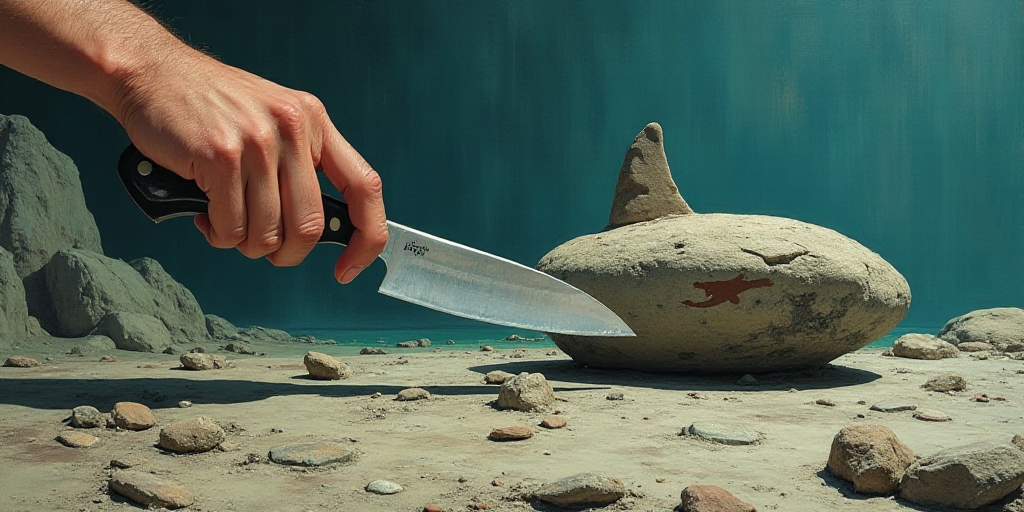Discovering the Past in Quintana Roo’s Cenote Maravilla
In the depths of Cenote Maravilla, located in Puerto Morelos, Quintana Roo, at 28 meters underwater, diver Juan Cardona discovered two prehistoric shark teeth in 2019. These teeth belong to the species Otodus (Megaselachus) megalodon, known as the largest aquatic predator from prehistory.
The Discovery and Analysis
One of the teeth belongs to a juvenile specimen, while the other, larger one is similar in size to an adult human hand. It was found embedded in a limestone rock conglomerate, alongside other marine fossil evidence. Both teeth are now on display in Sala 1 of the Regional Museum of the Eastern Coast, managed by the National Institute of Anthropology and History (INAH) in Tulum.
Before the exhibition, researchers from the Gran Acuífero Maya (GAM) project studied the teeth after Cardona alerted them of their discovery and handed over the smaller tooth, indicating additional fossils within the acuífer.
Expert Analysis and Historical Significance
Paleontologist Gerardo González Barba, an expert in fossil sharks and a researcher at the Autonomous University of Baja California Sur, analyzed high-resolution images to confirm that the teeth belong to the cosmopolitan species Otodus (Megaselachus) megalodon.
González Barba’s findings were presented at the XVI National Paleontology Congress in Chihuahua, 2019, marking the first scientific record of this extinct species in the territory now occupied by Quintana Roo.
According to González Barba, the teeth date back to the Miocene-Pliocene era (23 to 2.5 million years ago). One tooth belongs to a juvenile specimen, while the larger one is from an adult megalodon.
Geological Context and Reproduction Hypothesis
González Barba explains that these teeth likely fell to the seafloor over 15 million years ago when the Yucatan Peninsula was submerged, and the cenote hadn’t formed yet. Calcareous mud deposited in depths no greater than 200 meters, embedding the teeth among rock layers.
Approximately 100 million years ago, the Yucatan Peninsula was underwater; it emerged around 15 million years ago. This event triggered karstic dissolution, a weathering process that degrades limestone rocks and forms caves.
Protection and Digital Preservation
To prevent looting, the second tooth was recovered in 2021 by the GAM team using a scientific protocol.
The megalodon, reaching up to 18 meters in length—twice that of the great white shark—roamed Earth between 20 and 2 million years ago during the Miocene (23 to 5 million years ago) and Pliocene (5 to 2.5 million years ago) epochs in all oceans except polar regions.
Mexico has records of megalodon remains in Baja California’s outcrops, Palenque in Chiapas, and Yucatan Peninsula caves and cenotes. However, this is the first documented discovery of its kind in Quintana Roo.
The GAM study suggests that this Quintana Roo region could have been a breeding and feeding ground for Otodus (Megaselachus) megalodon when the territory was submerged underwater.
Digital Conservation Efforts
As part of the GAM Digital Preservation Project, Guillermo de Anda and his team, supported by the Swiss Embassy in Mexico, National Geographic Society, Dive Rite, Seahorse 360, and Creative DataBases, created digital reproductions of the fossil elements to preserve the cultural heritage of Yucatan Peninsula caves and cenotes.
Key Questions and Answers
- Who discovered the shark teeth? Diver Juan Cardona found the teeth in Cenote Maravilla, Quintana Roo.
- What species do the teeth belong to? The teeth are from Otodus (Megaselachus) megalodon, an extinct prehistoric shark.
- When were the teeth discovered? The discovery was made in 2019.
- Where are the teeth on display? The teeth are exhibited in Sala 1 of the Regional Museum of the Eastern Coast in Tulum, managed by INAH.
- What is the significance of this discovery? This marks the first scientific record of megalodon presence in Quintana Roo.
- What is the estimated age of the teeth? The teeth date back to the Miocene-Pliocene era (23 to 2.5 million years ago).
- What efforts are being made to protect and preserve the fossils? The GAM project includes digital preservation efforts, as well as scientific recovery protocols to prevent looting.






